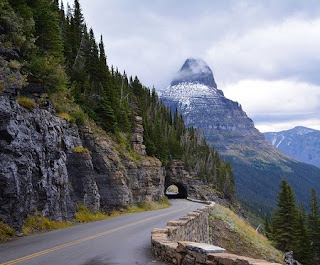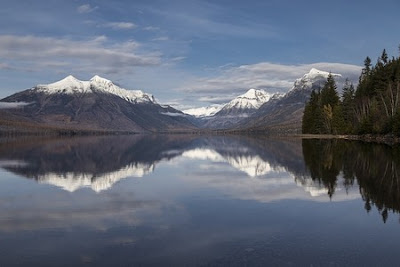Montana is called the Treasure State for the mineral and rock treasures. It
could also be called that for all its beauty as well. Montana is also called Big Sky Country, and when you
look around in Montana, the sky seems to go on forever.
Glacier National Park
A vacation in Montana
might start with Glacier National
Park located on the Canadian border in
northwestern Montana. This
National Park that is shared with Canada
is also called Waterton-Glacier International
Peace Park.
The main road through the middle of the park is called Going-to-the-Sun-Road.
It is 52 miles of a paved two lane with spectacular sights and is both a
National Historic Landmark and National Civil Engineering Landmark. The road
has been described as the don’t look down road and for good reason as it
goes over the Continental Divide at Logan
Pass. It is not for those that are afraid of heights.
 |
| Going to the Sun Road in Montana / Pixabay |
Montana is a
big wide-open state and Glacier National
Park is just like that, big. Glacier
National Park has more than 700
miles of maintained hiking trails in some of the country’s most remote areas.
Getting to the trailheads is easy as there is a shuttle ride offered to all
major trail heads on the Going-to-the-Sun road from July 1 through Labor Day.
While hiking you will see mountain goats climbing steep cliffs and you might
just see a bear, just remember common sense when around these animals and do
not approach them, they are not the family dog.
There is of course great fishing on some of the lakes. You
do not need a fishing license when fishing in the park, but you will when
fishing on any of the streams or rivers that form the boundary of the park. Be
careful when cleaning any fish, use the provided trashcans since this is bear
country and you don’t want any grizzly bears for dinner at your camp. Some of
the better lakes to fish are Elizabeth,
Ellen Wilson, Grace, Hidden and Isabel
Lakes. Lake
fishing is usually better than stream fishing except for the North
Fork of the Flathead. Because of the spring runoff the best river
fishing is mid-July through September.
If you don’t feel like driving through the park, you can
take a Red Bus Tour of the park and sit back and enjoy while someone
else does the driving. Glacier Park Inc. runs these bus tours and several of
the beautiful lodges in the park including the Lake McDonald Lodge, Glacier
Park Lodge, Prince of Wales Hotel, Village Inn at Apgar and Many Glacier Hotel.
Flathead Lake
Just west of Glacier National Park is the large and
beautiful Flathead Lake,
one of the most scenic and enjoyable places I have ever been to. To the north
of the lake are the towns of Whitefish and Kalispell and on the south end is
Polson. Surrounding the lake are little towns and villages mainly on the west
side. Flathead Lake
was created by glaciers and is thirty miles long and fifteen miles across with
a shoreline of 160 miles. There are all types of water sports from fishing to
boating. You can take a boat trip to Wild
Horse Island,
which is a 2,000-acre State Park in the middle of Flathead
Lake and watch bighorn sheep, mule
dear, bald eagles, falcons and wild horses.
Southwestern Montana
This is the place where you can hunt for rocks of all kinds
including gold, garnet, agate and sapphires.
In the winter, this area has some of the finest ski areas in
the country. This is where you can ski in deep powder practically alone at
times and short waits for the ski lift. Big Sky resort has 150 trails and 18
lifts. Other ski resorts are Red Lodge, Moonlight Basin Ski Resort, Bridger
Bowl just north of Bozeman,
Snowbowl near Missoula, Discovery
Basin near Anaconda and Maverick
Mountain.
Yellowstone National Park
Yes, Yellowstone is also in Montana.
On the Wyoming border with Montana southwest of Billings is Yellowstone
National Park, an amazing 2.2 million acres and 10,000 thermal wonders like Old
Faithful erupting every 90 minutes along with 300 other steaming geysers, 200
waterfalls, 1,100 historic buildings, 200 species of birds and 950 miles of
hiking trails. Lower and Tower Falls
are the two most popular waterfalls in the park.
The thermal activity in the park is a reminder of a
cataclysmic volcanic eruption 600,000 years ago. A partially molten magma
chamber is a remnant of this eruption. Water from rain and snow seeps into this
chamber and is heated until it bubbles or erupts in the form of the steaming
geysers. Other places it forms limestone terraces. You can see this growing
today at Mammoth Hot Springs and Opal Springs.
Yellowstone is a natural geological
wonder with incredible scenery. Along with geological wonders there is also the
wildlife including grizzly bears, wolves, bison and elk.
Little Bighorn National Monument
East of Billings, Montana is the area where Custer’s Last
Stand took place. In 1876, Lt. Col. George A. Custer and 263 of his men battled
with Lakota and Cheyenne warriors.
This was one of the last battles of the Northern Plains. This area memorializes
one of the last armed efforts of the Northern Plains Indians.
North Central Montana and C.M. Russell country
This area is beautiful in its own way, north of Billings
to the Canadian border on the north and the Rocky Mountains
to the west. This is the area where artist Charles Russell was inspired to
paint his wonderful paintings. The C.M. Russell museum is located in Great
Falls, Montana. The Upper
Missouri River Breaks
National Monument is located in
this area near Lewistown with historic trails, beautiful scenery, fishing,
birding, hiking, canoeing and camping. The Lewis and Clark trail went through
here as well as the Old North Trail, one of the oldest trails known to man.
25,000 years ago this trail extended from the ice bridge between Siberia
and Alaska to Mexico.
The Old North
Trail Museum
is located in Choteau.
Northeast Montana, The Missouri River
Northeastern Montana is where the Missouri
River flows through, creating a wonderful hunting, fishing and
recreation area. Fort Peck
Reservoir has 1,500 miles of shoreline with great fishing, hunting, camping,
boating and waterskiing. This is the eastern end of the Charles M. Russell
National Wildlife Refuge, which extends 125 miles westward from Fort
Peck.
Lewis and Clark Trail
Throughout Montana
are signs and markers where the Lewis and Clark expedition went through. For
example, east of Billings there is
Pompey’s Pillar. Clark inscribed his name and date in
the rock on July 25, 1806.
From the Lewis
and Clark web site you can find all of these sites with GPS readings
listed.
Copyright © 2009 Sam Montana
You can check here for current road status of the Going-To-The-Sun Road.



No comments:
Post a Comment